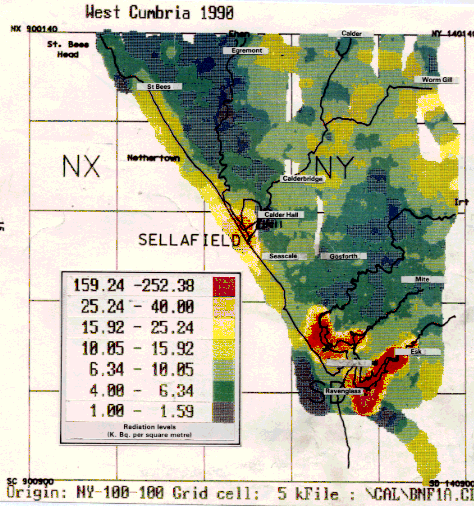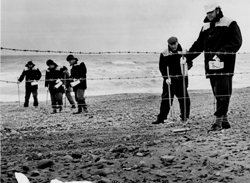|
Since
the 1950's Sellafield has pumped a quarter of a tonne of plutonium and
a cocktail of other radioactive isotopes out of twin sea discharge pipes
into the Irish Sea. Because the radioactive pollution is detectable
the pollution can be traced as it flows into the seas around Britain.
In April 1997 the Bedford Institute of Oceanography, Nova Scotia found
Sellafield radiation had reached the Arctic.

In 1990 a government funded project used helicopters to survey radiation
"hot spots" in the area. The map (above) shows the radiation
levels are highest (red and brown) around the estuary of the Rivers
Esk and Mite and around Sellafield itself. In March 2001 the University
of Glasgow REACTORS team at East Kilbride will complete a further helicopter
monitoring survey for the DETR.
State-owned
British Nuclear Fuels (BNFL) has invested heavily in technology such
as its EARP and SIXEP (Site Ion Exchange Plant) to remove as much of
the pollution as possible. They have cut discharges of radioactivity
by 100 fold since the mid 1970's. But the legacy from earlier, less
careful days, mean that silts and sediments are laced with low level
contamination.
This contamination enters Irish Sea fish and shellfish. The UK Government's
RAWMAC 11th annual report in 1990 warned "there is still some concern
about the fate of the larger quantities of radioactivity discharged
in the past. "
"The plutonium and americium (decays into plutonium) in the discharges
have been found not to disperse but to concentrate in the fine cohesive
sediments of the Irish Sea.''
In 1976 an un-noticed leak from a waste silo led to 50,000 curies of
radiation seeping out. Media attention was at it peak in 1983 when radioactive
ruthenium was allowed out to sea and washed back onto the holiday beaches.Beach
contamination was reproted in Feb 23 1984 issue of Whitehaven News.
The public were told to stay away from the contaminated beaches and
BNFL was stung by a £70,000 court bill for the leak. It was this same beach that in 1992 was the target for a public attack
by the rock band U2 with the group's singer Bono teaming up with Greenpeace
to protest at the radioactive waste being dumped out to sea. Greenpeace
at one stage sent hired divers down to the undersea section of the Sellafield
discharge pipelines and succeeded in inserting inflatable bungs which
brought reprocessing briefly to a halt. The most recent instances of
the effects of the pollution have been that in 1997 technetium (a dangerous
radioactive isotope) were found to be exceeding EEC safe intervention
level in lobsters.
It was this same beach that in 1992 was the target for a public attack
by the rock band U2 with the group's singer Bono teaming up with Greenpeace
to protest at the radioactive waste being dumped out to sea. Greenpeace
at one stage sent hired divers down to the undersea section of the Sellafield
discharge pipelines and succeeded in inserting inflatable bungs which
brought reprocessing briefly to a halt. The most recent instances of
the effects of the pollution have been that in 1997 technetium (a dangerous
radioactive isotope) were found to be exceeding EEC safe intervention
level in lobsters.
And a bizarre example of how radioactive contamination can just spread
through the eco-system came in 1998 when 700 feral pigeons that used
a nearby garden as a roost were found to be so contaminated BNFL had
to take away part of the garden's top soil it was so polluted. The pigeons
had been roosting in semi-derelict parts of the vast Sellafield site.
They had then been flying three miles to nearby Seascale village to
be fed by animal lovers. The UK Ministry of Agriculture then issued
warnings that the public should not consume local pigeon meat.
Over the last 20 years BNFL has reduced Sellafield discharge levels
to less than 1% of their peak levels. In the past 10-15 years the company
has invested more than £2billion in waste management and effluent
treatment facilities.
But the legacy will never end..as a June 2003 report adds..RADIOACTIVITY
in the ground water under Sellafield is spreading into the sandstone
rocks under the area. The subject was raised by former BNFL manager
Allan Whittaker as a member of the public at the Sellafield Local Liaison
meeting at Whitehaven civic hall on Friday. The Environment Agency spokesman
Andrew Ferguson confirmed at the meeting that it has been aware of the
radioactivity getting into groundwater for some time. They told the
meeting: "Latest results indicated that contamination of groundwater
is slightly more wide spread laterally, than previously thought. In
addition both tritium and technetium99 have been detected in the sandtsone
aquifer, which underlies Sellafield." In June 2009 A LEAK of radioactivity
which has lasted for half a century at Sellafield was finally plugged.The
radioactive water is known to have seeped into the ground under the
nuclear site for up to 50 years and the public was first told about
it in the 1970s, since which time it has been monitored regularly at
safe levels. But it is one of the radiation sources which has led to
contamination on local beaches. The liquid has seeped from a crack in
one of four huge concrete waste tanks which in the past processed effluent
before being discharged into the Irish Sea. The seepage was first reported
in the 1970s but at the time the technical know-how was not available
to do anything about it. But this week The Whitehaven News was told
the leak has been plugged and the site’s new landlords, Nuclear
Management Partners, have hailed it as a big environmental breakthrough
thanks to technology developed at Sellafield.
Recommended reading is Inside Sellafield by an insider who should
know...former BNFL Director, Harold Bolter (Published by Quartet-ISBN
0 7043 8017 X)
|
In
2013 Eight years after it was produced from
material gathered from the West Cumbrian coast near Waberthwaite,a radioactive
‘Pizza Cumbriana’ has finally been delivered to the Low Level
Waste (LLW) facility at Drigg for disposal as LLW. Originally presented
by CORE in March 2005 to the Italian Embassy in London as evidence of
the environmental contamination caused by the reprocessing of Italian
and other foreign spent fuel at Sellafield, the condemned pizza has languished
with other LLW at the Atomic Energy Research Establishment at Harwell
until 22nd February 2013 when it was transported by road to its rightful
resting place at Drigg.
The
levels of radioactivity included 25,000 Bq/kg of Caesium 137, 25,000
Bq/kg of Americium 241 and levels of plutonium up to 15,000 Bq/kg. A
subsequent report produced by Harwell Scientifics Ltd for the Environment
Agency ‘Analysis of a Pizza Comprising of Sediment’ (RD 0693)
confirmed the presence of high levels of Caesium 137, Americium 241,
and Plutonium 238, 239 and 240.The radioactive half-life of Plutonium
239, an alpha (particle) radiation emitter is 24,400 years. The levels
of radioactivity found by CORE along the West Cumbrian coast are absent
from official annual monitoring reports because official sampling of
mud and sediment consists of a 1cm deep sample being taken for analysis
to compare annual discharge trends. Such shallow sampling completely
ignores the historic build-up of radioactivity at those depths greater
than 1cm routinely disturbed by holidaymakers, fishermen. dog walkers
and children etc.. CORE website
To find
out more about Sellafield, the following web sites may be helpful.
Norwegian Government report 2009
on risks of release from high level liquid waste tanks.
|


 It was this same beach that in 1992 was the target for a public attack
by the rock band U2 with the group's singer Bono teaming up with Greenpeace
to protest at the radioactive waste being dumped out to sea. Greenpeace
at one stage sent hired divers down to the undersea section of the Sellafield
discharge pipelines and succeeded in inserting inflatable bungs which
brought reprocessing briefly to a halt. The most recent instances of
the effects of the pollution have been that in 1997 technetium (a dangerous
radioactive isotope) were found to be exceeding EEC safe intervention
level in lobsters.
It was this same beach that in 1992 was the target for a public attack
by the rock band U2 with the group's singer Bono teaming up with Greenpeace
to protest at the radioactive waste being dumped out to sea. Greenpeace
at one stage sent hired divers down to the undersea section of the Sellafield
discharge pipelines and succeeded in inserting inflatable bungs which
brought reprocessing briefly to a halt. The most recent instances of
the effects of the pollution have been that in 1997 technetium (a dangerous
radioactive isotope) were found to be exceeding EEC safe intervention
level in lobsters.